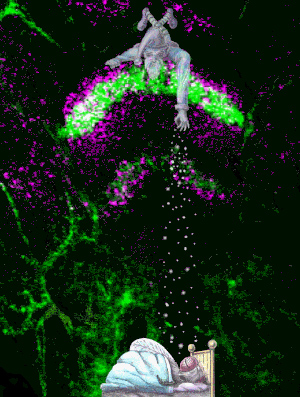
Scientists have identified an area in the fruit fly brain (highlighted in green and pink, under the sandman illustration) with cells that can put flies to sleep.
Scott Loebl, Asa Winther, Cassandra Vandunk
Rather than count sheep, drink warm milk or listen to soothing music, many insomniacs probably wish for a switch they could flick to put themselves to sleep.
Scientists at Washington University School of Medicine in St. Louis have discovered such a switch in the brains of fruit flies. In a study appearing June 24 in Science, the researchers show that a group of approximately 20 cells in the brains of fruit flies controls when and how long the flies sleep. Slumber induced through this sleep switch was essential to the creation of long-term memory, directly proving a connection between memory and sleep that scientists have long suspected.
“This is exciting because this induced sleep state so far appears to be very similar to spontaneous sleep,” says Paul Shaw, PhD, associate professor of neurobiology. “That means we can manipulate these cells to explore a whole new realm of questions about the purposes of sleep. Such studies might one day lead us to more natural ways of inducing sleep in humans.”
The key cells are found in an area of the fly brain known as the dorsal fan-shaped body. Scientists in Shaw’s lab genetically modified the cells to increase their activity. One effect of making these cells more active was that adult flies slept for an additional seven hours a day.
When scientists added a gene that increases the cells’ activity only at warmer temperatures, they could determine when and how long flies would sleep by simply adjusting the temperature in the flies’ habitats.
To analyze the similarity of induced sleep to spontaneous sleep, scientists tested whether induced slumber was essential to the formation of long-term memories. In a process called courtship conditioning, male flies were exposed to other males genetically modified to make female sex pheromones.
“The subject fly will initiate courtship because of the female pheromones, but the modified male making those pheromones inevitably rejects him,” says first author Jeff Donlea, PhD, now a postdoctoral research assistant at Oxford University. ”This is an ecologically relevant way to test memory because a male fly in the wild needs to quickly assess whether a particular female is interested in mating so that he doesn’t waste time making unproductive advances.”
The researchers used a training protocol that normally only creates a memory that lasts a few hours in fruit flies. After being “rejected” multiple times over three hours, the fly learns not to make advances when he encounters the altered male again at a later time. But when scientists used the cells in the dorsal fan-shaped body to put the fly to sleep immediately after training, the fly formed a long-term memory of his experience that lasted for at least several days.
To rule out the possibility that the increased excitability of the cells could be directly responsible for the long-term memory, scientists activated the sleep-regulating cells following training but prevented the flies from sleeping. The flies did not remember the training, indicating that sleep itself was important for the consolidation of memory.
Scientists have yet to determine whether a counterpart for the dorsal fan-shaped body exists in human brains. Shaw’s lab is currently working to see if the cells they singled out can be matched to other brain cell types based on the chemical messengers they produce.
Donlea JM, Thimgan MS, Suzuki Y, Gottschalk L, Shaw PJ. Inducing sleep by remote control facilitates memory consolidation in Drosophila. Science, June 24, 2011.
Funding from the National Institutes of Health (NIH) supported this research.
Washington University School of Medicine’s 2,100 employed and volunteer faculty physicians also are the medical staff of Barnes-Jewish and St. Louis Children’s hospitals. The School of Medicine is one of the leading medical research, teaching and patient care institutions in the nation, currently ranked fourth in the nation by U.S. News & World Report. Through its affiliations with Barnes-Jewish and St. Louis Children’s hospitals, the School of Medicine is linked to BJC HealthCare.